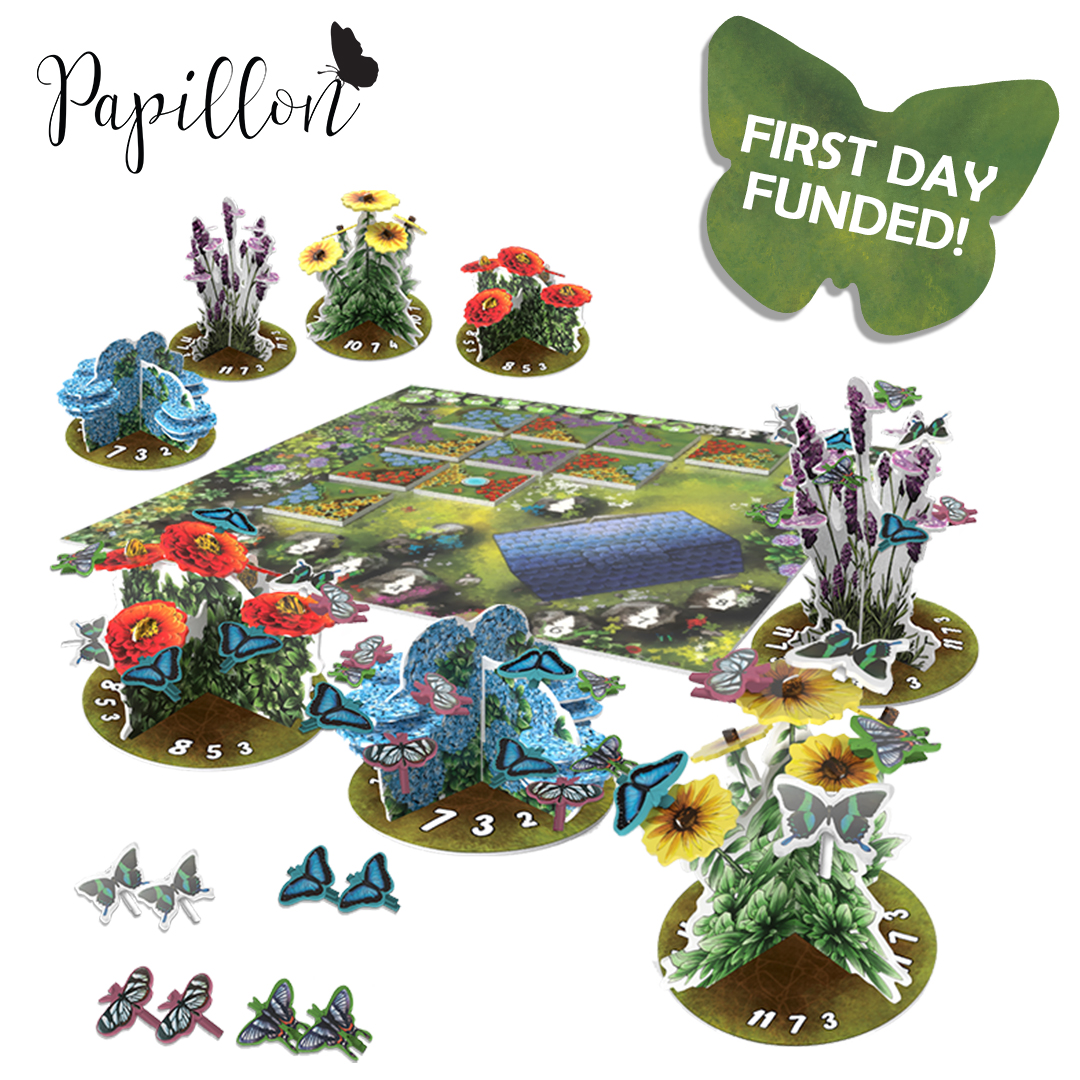Who knew a game about butterflies could be this cutthroat?
Papillon is a tile drafting, area control game for 2-4 players where each player takes on the role of a gardener trying to get their butterflies to collect the most nectar.
We sat down with designer J.B. Howell of Papillon to talk a little more in depth about the strategy and gameplay involved in this, at first glance, lighter game.
Take it away J.B.!
Papillon has several scoring opportunities for players, and while there are more options with expansion content, your strategy will typically manifest into three main avenues of play: all out flower control, all out garden building, and an opportunistic blend of both.
When pursuing a strategy of all out flower control, you really want to focus your draft on tiles that share two qualities. You’ll want to look for tiles that have small flower patch wedges that are easy to close quickly so you can get as many of your butterflies out to flowers as fast as possible. And because you’re going for all out flower control, you’re going to want to utilize as many of the four available colors as possible.
 Closing flower patches is the key to getting butterflies on the stand-up flowers and you want to spread your butterflies around. The gnome is not quite as useful in this strategy unless it is providing you two Caterpillars that you can use for drafting the tiles you need. You’ll find yourself running low on Caterpillars often as you’ll be wanting to ensure that you are able to draft the specific tiles you’ll need to close those patches. The ideal draft for this strategy is to get 3 or 4 tiles as often as possible, with color variety and avoiding the tiles that have large flower patches on them as those will often stagnate your turns attempting to close them off.
Closing flower patches is the key to getting butterflies on the stand-up flowers and you want to spread your butterflies around. The gnome is not quite as useful in this strategy unless it is providing you two Caterpillars that you can use for drafting the tiles you need. You’ll find yourself running low on Caterpillars often as you’ll be wanting to ensure that you are able to draft the specific tiles you’ll need to close those patches. The ideal draft for this strategy is to get 3 or 4 tiles as often as possible, with color variety and avoiding the tiles that have large flower patches on them as those will often stagnate your turns attempting to close them off.
The next primary strategy for Papillon is to focus on all out garden building. When pursuing this strategy, you’ll want to focus on sticking to two primary colors as diversifying too much can hurt your end game scoring. Work on drafting larger patch tiles with only two colors of flowers on them whenever possible, try to get lots of monarch butterflies on tiles as well, and don’t forget about the gnome to help you increase the score of each of your patches.
 Only your two largest flower patches score at the end, so it is not necessary to build many large patches, just two of them. If you can get 3 or 4 of the tiles with large flower patches on them (2 or 3 sides in the same color on the tile) then you can really get a good 5-8 tile patch for final scoring. Focus on building and closing those two patches, with Gnomes to boost their value, and close in as many butterflies as you can in the fields (also with Gnomes if available). The ideal draft for this strategy is to make sure you get exactly the right tiles in the colors you need or grab two tiles and the Gnome.
Only your two largest flower patches score at the end, so it is not necessary to build many large patches, just two of them. If you can get 3 or 4 of the tiles with large flower patches on them (2 or 3 sides in the same color on the tile) then you can really get a good 5-8 tile patch for final scoring. Focus on building and closing those two patches, with Gnomes to boost their value, and close in as many butterflies as you can in the fields (also with Gnomes if available). The ideal draft for this strategy is to make sure you get exactly the right tiles in the colors you need or grab two tiles and the Gnome.
As you play through games of Papillon you’ll often find that your well thought out strategy is being thwarted by the other players at the table. Either they are trying to use the same strategy as you, making the tile selection not as reliable, or they are just agents of chaos drafting whatever they feel like in the moment. Whatever the reason may be you’ll want to remain flexible and that is why a common strategy is the opportunist.

Whatever strategy you employ you’ll want to draft efficiently to be sure, but it’s even more important in the opportunistic strategy. Try to place just enough butterflies on undervalued flowers to score points where ever possible, and build a decent garden with a pair of moderately sized patches for end of game scoring, if you get a gnome along the way more power to you! Conserving Caterpillars at the end of the game for those bonus points as well to make sure you have a competitive Nectar total in all scoring areas at the end of the game.
Papillon is funding on Kickstarter until June 13th! So if you’d like to know more check out the Kickstarter page and consider becoming a backer!








